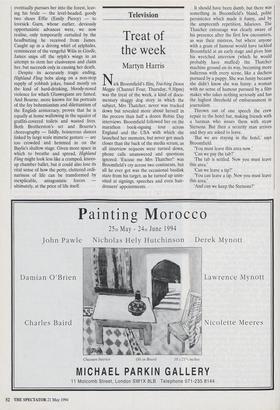Dance
Adventures in Motion Pictures (Lilian Baylis Theatre and touring)
Updating old favourites
Sophie Constanti
Since Spitfire, his rougish parody of Pas de Quatre — Jules Perrot's legendary, money-spinning divertissement made in 1845 for Marie Taglioni, Carlotta Grisi, Fanny Cerrito and Lucile Grahn, the prima (and thus rival) ballerinas of the day — Matthew Bourne has looked increasingly to Europe's ballet heritage as a source of con- temporary, and often very black, humour. Spitfire, created in 1988 for his dance the- atre troupe Adventures in Motion Pictures, featured four muscle-flexing, underwear- clad pretty boys in place of Pas de Quatre's female star quartet. But Bourne played knowingly and heavily on the arch bitchi- ness and competitive atmosphere which are said to have threatened Perrot's ballet in rehearsal. Two years ago he tackled The Nutcracker, showing an imaginative inter- pretation of Tchaikovsky's glorious score while paying scant respect to the ballet's traditional libretto and offering, instead, a camp, candified Prince who seemed more
interested in party games with the boys than in Clara.
Now, with Highland Fling, he has turned his attention to one of the oldest surviving ballets of the Romantic era, August Bournonville's La Sylphide — the supernat- ural tale of a doomed relationship between an alluring sylph and the susceptibly way- ward James, first performed in 1836 (with Pas de Quatre's Lucile Grahn as the Sylph). In Bourne's updated version, James (Scott Ambler), an unemployed welder, is more lad than cad, and the sylph (Maxine Fone) is a ghoulish, teasingly sadistic grunge waif. Although he retains substantial chunks of the buoyant Lovenskjold score to which Bournonville's La Sylphide is danced, Bourne relocates the action to a council flat in Glasgow and, for Act ii, transports us to an urban forest in which Gorbals tower blocks outnumber trees.
The prelude has James — whose deathly pallor and manic, wide-eyed stare mark him out as a dope fiend and, quite aptly, the work's addictive personality — stagger- ing into the gents at the Highland Horse Social Club Disco. After a quick fix he col- lapses against the stained urinal and, in his drug-induced dream, encounters the sylph. Six months later, still boozing away their evenings, James and his pals — Robbie (Andrew George) and Gum (Simon Mur- phy) — are, typically, to be found slumped across the living room where Lez Brother- ston's decor — a riot of tartan (walls, soft furnishings and, of course, clothing) plus tongue-in-cheek details such as a Bay City Rollers poster and Rangers scarf — exacer- bates rather than soothes the collective hangover.
On his wedding day, James is again visit- ed by the sylph who, invisible to the guests, causes mayhem as she flits in and out of the celebratory reels and flings. Haunted and intrigued by the ethereal creature, he eventually pursues her into the forest, leav- ing his bride — the level-headed, goody two shoes Effie (Emily Piercy) — to lovesick Gum, whose earlier, deviously opportunistic advances were, we now realise, only temporarily curtailed by the headbutting he received from James. Caught up in a driving whirl of sylphides, reminiscent of the vengeful Wilis in Giselle, James snips off the sylph's wings in an attempt to stem her elusiveness and claim her, but succeeds only in causing her death.
Despite its accurately tragic ending, Highland Fling bobs along on a non-stop supply of yobbish jokes, based mostly on the kind of hard-drinking, bloody-nosed violence for which Glaswegians are famed. And Bourne, more known for his portraits of the fey bohemianism and dilettantism of the English aristocracy, proves that he is equally at home wallowing in the squalor of graffiti-covered toilets and wasted lives. Both Brotherston's set and Bourne's choreography — fiddly, boisterous dances linked by large scale mimetic gesture — are too crowded and hemmed in on the Baylis's shallow stage. Given more space in which to breathe and spread, Highland Fling might look less like a cramped, knees- up chamber ballet, but it could also lose its vital sense of how the petty, cluttered ordi- nariness of life can be transformed by inexplicable, antagonistic forces — ultimately, at the price of life itself.





































































 Previous page
Previous page